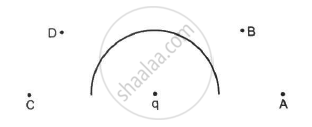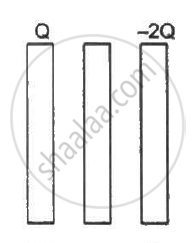Advertisements
Advertisements
Question
The radius of a gold nucleus (Z = 79) is about 7.0 × 10-10 m. Assume that the positive charge is distributed uniformly throughout the nuclear volume. Find the strength of the electric field at (a) the surface of the nucleus and (b) at the middle point of a radius. Remembering that gold is a conductor, is it justified to assume that the positive charge is uniformly distributed over the entire volume of the nucleus and does not come to the outer surface?
Solution
Given:
Atomic number of gold = 79
Charge on the gold nucleus, Q = 79 × (1.6 ×10-19) C The charge is distributed across the entire volume. So, using Gauss's Law, we get:
(a) `phi =oint vec"E". vec("d""s") = "Q"/∈_0`
`=> oint "E""d""s" = "Q"/∈_0`
The value of E is fixed for a particular radius.
`=> "E" oint "d""s" = "Q"/∈_0`
`=> "E" xx 4 pi "r"^2 ="Q"/∈_0`
`=> "E" ="Q"/(∈_0 xx 4 pi "r"^2)`
`"E" = ( 79 xx (1.6 xx 10^-19 ))/((8.85 xx 10^-12) xx 4 xx 3.14 xx ( 7 xx 10^-10)^2`
`"E" = 2.315131 xx 10^21 "N"//"C"`
(b) To find the electric field at the middle point of the radius:
Radius , `"r" = 7/2 xx 10^-10 m`
Volume, `"V" = 4/3 pi "r"^3`
`=4/3 xx 22/7 xx 343/8 xx 10^-30`
Net charge =79 ×1.6 ×10-19 C
Volume charge density
`= (79 xx 1.6 xx 10^-19)/(4/3pi xx 343 xx 10^-30) `
So, the charge enclosed by this imaginary sphere of radius r =3.5× 10 -10
`= (79 xx 1.6 xx 10^-19)/(4/3pi xx 343 xx 10^-30) xx 4/3 pi xx 343/8 xx 10^-30 `
`= (79 xx 1.6 xx 10^-19)/8`
`=> "E" = (79 x 1.6 xx 10^-19)/(8 xx4pi ∈_0."r"^2)` at r = 3.5× 10-10
= 1.16 × 1021 N/C.
As electric charge is given to a conductor, it gets distributed on its surface. But nucleons are bound by the strong force inside the nucleus. Thus, the nuclear charge does not come out and reside on the surface of the conductor. Thus, the charge can be assumed to be uniformly distributed in the entire volume of the nucleus.
APPEARS IN
RELATED QUESTIONS
(i) If two similar large plates, each of area A having surface charge densities +σ and –σ are separated by a distance d in air, find the expressions for
(a) field at points between the two plates and on outer side of the plates. Specify the direction of the field in each case.
(b) the potential difference between the plates.
(c) the capacitance of the capacitor so formed.
(ii) Two metallic spheres of Radii R and 2R are charged so that both of these have same surface charge density σ. If they are connected to each other with a conducting wire, inn which direction will the charge flow and why?
Two identical circular loops 1 and 2 of radius R each have linear charge densities −λ and +λ C/m respectively. The loops are placed coaxially with their centres `Rsqrt3` distance apart. Find the magnitude and direction of the net electric field at the centre of loop 1.
Why is the potential inside a hollow spherical charged conductor constant and has the same value of as on its surface?
In the following figure shows a charge q placed at the centre of a hemisphere. A second charge Q is placed at one of the positions A, B, C and D. In which position(s) of this second charge, the flux of the electric field through the hemisphere remains unchanged?
(a) A
(b) B
(c) C
(d) D

Consider the following very rough model of a beryllium atom. The nucleus has four protons and four neutrons confined to a small volume of radius 10−15 m. The two 1 selectrons make a spherical charge cloud at an average distance of 1⋅3 ×10−11 m from the nucleus, whereas the two 2 s electrons make another spherical cloud at an average distance of 5⋅2 × 10−11 m from the nucleus. Find three electric fields at (a) a point just inside the 1 s cloud and (b) a point just inside the 2 s cloud.
A long cylindrical wire carries a positive charge of linear density 2.0 × 10-8 C m -1 An electron revolves around it in a circular path under the influence of the attractive electrostatic force. Find the kinetic energy of the electron. Note that it is independent of the radius.
One end of a 10 cm long silk thread is fixed to a large vertical surface of a charged non-conducting plate and the other end is fastened to a small ball of mass 10 g and a charge of 4.0× 10-6 C. In equilibrium, the thread makes an angle of 60° with the vertical (a) Find the tension in the string in equilibrium. (b) Suppose the ball is slightly pushed aside and released. Find the time period of the small oscillations.
Three identical metal plates with large surface areas are kept parallel to each other as shown in the following figure. The leftmost plate is given a charge Q, the rightmost a charge −2Q and the middle one is kept neutral. Find the charge appearing on the outer surface of the rightmost plate.

A simple pendulum consists of a small sphere of mass m suspended by a thread of length l. The sphere carries a positive charge q. The pendulum is placed in a uniform electric field of strength E directed vertically downwards. Find the period of oscillation of the pendulum due to the electrostatic force acting on the sphere, neglecting the effect of the gravitational force.
Electric field at a point is defined as ______.
The force per unit charge is known as ______.
Pick out the statement which is incorrect
Two charged conducting spheres of radii a and b are connected to each other by a wire. Find the ratio of the electric fields at their surfaces.
